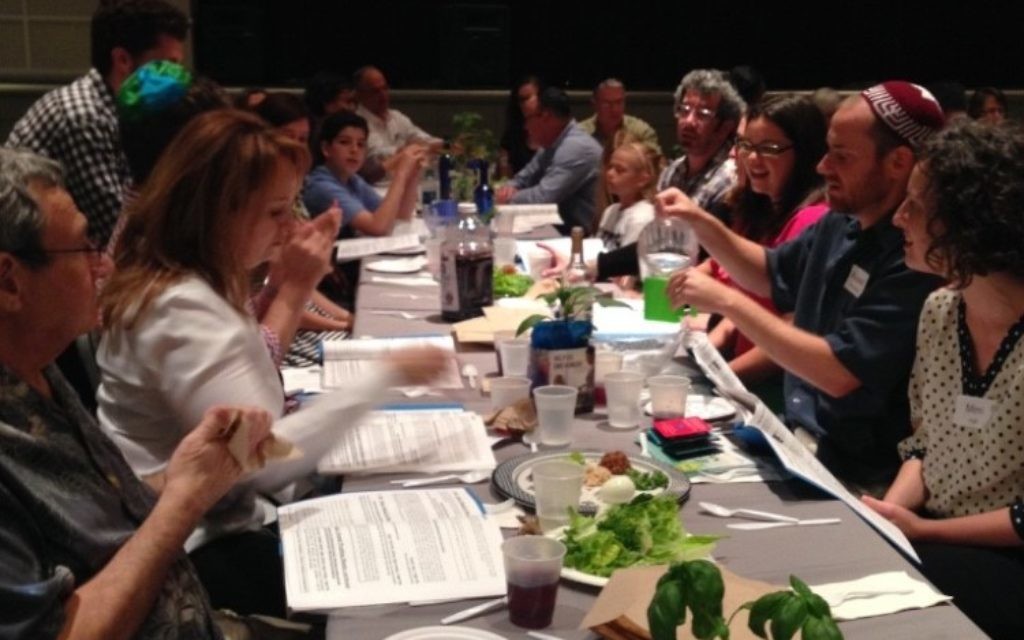Hunger Seder: Satisfaction Through Action
The fifth annual Atlanta Hunger Seder did more than educate attendees about food insecurity in the area; it drove home the need for immediate activism.
Representatives of World Pilgrims/Interfaith Community Initiative, Neshama and the Faith Alliance of Metro Atlanta mixed with Jewish community members in a crowd of around 100 spanning generations and backgrounds at Ahavath Achim Synagogue on Wednesday night, April 27. They heard about the impact each individual can make in the fight against hunger and found opportunities for action interspersed throughout the evening.
At check-in, each person was given two labels with contact information. Throughout the seder, hunger relief agencies including Food Security America, Second Helpings Atlanta, Gideon’s Promise, Concrete Jungle, Jewish Family & Career Services’ Kosher Food Pantry and Maos Chitim, Global Growers, and the Atlanta Community Food Bank talked about opportunities for participation and advocacy in the fight against hunger. People later could stick their labels on the easels of the agencies with which they most wanted to engage over the year.
Get The AJT Newsletter by email and never miss our top stories Free Sign Up
AA Rabbi Laurence Rosenthal led the seder, assisted by Harold Kirtz of the Jewish Community Relations Council of Atlanta.
Inspired by the Hunger Seder Haggadah published by the Jewish Council for Public Affairs in 2012, the modified service paralleled traditional seder components with new awareness-raising elements.
The story of the deliverance of the Jewish people from Egyptian slavery to freedom was contrasted with the enslavement of those struggling with hunger and poverty today. In Georgia more than a quarter of children endure food insecurity, or a lack of access to nutritional food. One in 10 senior citizens lives in poverty, while 46.5 million, or 14.5 percent of all Americans, exist below the poverty line.
Each of the four cups of wine, symbolizing the promises of freedom made to the Israelites as they were led out of bondage, was paired with a new promise we will undertake in the fight against hunger.
With the washing of the hands Rabbi Rosenthal reminded us that ours are the hands that can bring hope. He asked us how we have used our hands since the last seder. Whom have our hands helped?

The Four Questions brought a discussion of hunger-related questions, such as:
- Why does so much food go to waste when so many people in our country are starving?
- Why is fast food so inexpensive while healthy, nutritional food is so costly?
- Why can’t we solve these problems?
The Ten Plagues were paired with Ten Plagues of Today, concluding with apathy, the greatest plague of all — the failure to make ending hunger a national priority.
Midway through the seder, Kirtz spoke about efforts to reauthorize federal child nutrition programs that expired in September. Attendees had the opportunity to fill out postcards to their representatives, asking that the funding be reinstated.
Forsaking the event’s name, no one attending the Hunger Seder left hungry. The traditional meal was once prepared by executive chef Jodie Sturgeon and her team at Atlanta Kashruth Commission-certified For All Occasions and More.
The matzah balls, the size of baseballs, were sublime. The gefilte fish was spot-on. The meal, including a sweet kugel and a savory kugel, was wonderful. With the exception of the chicken, all items were vegetarian. Flourless chocolate cake and mammoth macaroons rounded out the meal.
The most impactful action component came into play at the end of the evening. When the seder concluded, everyone, including the children, returned to the buffet line to package up the leftovers into individual meals, which were loaded onto the Second Helpings truck. Those who wanted to then drove by caravan to Peachtree and Pine streets to distribute the packages to those in need on the streets of Atlanta.
The immediate action steps imparted a feeling of empowerment that complemented the thoughtful, fulfilling event.
Photos by Leah R. Harrison







comments